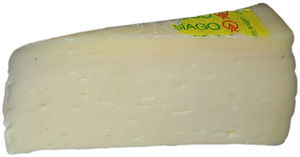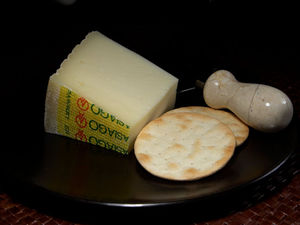Asiago cheese
Asiago cheese (azi'ago) is an Italian cheese that according to the different aging can assume different textures, from smooth for the fresh Asiago cheese (Asiago Pressato) to a crumbly texture for the aged cheese (Asiago d'allevo) of which the flavor is reminiscent of sharp Cheddar and Parmesan. The aged cheese is often grated in salads, soups, pastas, and sauces while the fresh Asiago cheese is sliced to prepare panini or sandwiches; it can also be molten on a variety of dishes. Asiago is treated as interchangeable with the parmesan and romano cheeses in some cuisines.
As Asiago has a protected designation of origin (Denominazione di Origine Protetta or DOP, see below), the only "official" Asiago cheese is produced in the alpine area of the town of Asiago, province of Vicenza, in the Veneto region, and now is also made in the Alpine region of the Province of Trento, which has become part of the DOP area for Asiago cheese production. Most Asiago cheese in the world, however, is made elsewhere using techniques and cultures that produce a cheese of the same or similar flavor.
Production
Asiago is produced in co-ops, specialized groups of local dairies which provide high-quality grassfed cow's milk. Alpine milk is what makes Asiago a special, healthy cheese. Alpine meadows have a larger variety of grass species, medicinal plants and flowers all of which contribute to a better tasting milk with a higher protein content.
Protected designation of origin
Asiago cheese is an Italian D.O.P. product (Denominazione di Origine Protetta), equivalent to a Protected Designation of Origin (PDO). This simply means that the product can be considered as real by European law if and only if it is produced in its specific origin area, and according to a specific regime, known as the Disciplinare di produzione. The EU law does not necessarily apply outside the European Union. Previously it had enjoyed protected status in a number of European countries with which Italy had bi-lateral agreements under the Denominazione d’Origine awarded by the presidential decree of 21 December 1978 and subsequently modified by the prime-ministerial decree of 1993-08-03, and by the ministerial decree of 1995-06-06 under which the current Disciplinare came into force. [1],[2]
An American-made Asiago-type cheese is also available, usually made in Wisconsin. It tastes completely different from the original Asiago with typically pleasant butterscotch undertones that intensify when aged.
Varieties
Fresh Asiago cheese is tender and can be used in the preparation of sandwiches and panini or as a table cheese. Aged Asiago cheese can be used for grating and as a table cheese. The aged Asiago cheese can be granular, like Parmesan or aged Gouda, and can feature a bit of a crunch due to a buildup of Tyrosine, an amino acid found in milk that crystallizes over time in aged cheeses. The more Tyrosine found in milk the higher quality the milk and a considerable amount has to be present for it to crystalize; therefore a crystalin texture is considered a sign of high quality in aged cheese. Aged Asiago cheese features a very concentrated, complex variety of flavors ranging from the fruity, to the nutty, to the pungent. Some wheels can even taste a little like toasted bread.
Traditional asiago
This cheese is available in flavors ranging from fresh to mild to aged, and the types are described by their flavor. Dolce describes a mildly spicy asiago, several months old; medio describes a stronger product, aged longer; and piccante asiago is a hard, aged cheese with a piquant flavor, suitable for grating. Piccante asiago is also enjoyed as a flavorful table cheese, eaten in paper-thin slices.
Asiago d’Allevo
This is the mature, hard cheese. It is produced from skimmed raw cows’ milk and sold in flat cheese wheels weighing 18 to 31 pounds (8 to 14 kg). It is marketed as fresh (fresco) asiago, aged two to three months, good for sandwiches and salads, and medium-ripe (mezzano), aged four to five months. Slow-ripened (vecchio) asiago, aged nine months or longer, is a table cheese, also suitable for cooking.
Preparation, uses, and tips
Asiago is enjoyed as a complement to pasta, rice, pizza, or soup. It can also be served with hearty bread, salami, or such fruits as fresh figs or pears, and it goes well with a variety of beverages such as red wine, cranberry juice, and sparkling grape juice.
Nutritional highlights
- Asiago cheese, 1 oz (28 g)
- Energy: 110 calories (460 kJ)
- Protein: 7.5 g
- Carbohydrate: 0.67 g
- Total Fat: 8.7 g
- Fiber: 0.0 g
- Excellent source of: Calcium (226 mg)
- Good source of: Phosphorus (145 mg)
Foods that are an “excellent source” of a particular nutrient provide 20% or more of the Recommended Daily Value. Foods that are a “good source” of a particular nutrient provide between 10 and 20% of the Recommended Daily Value.
External links
- Consorzio Tutela Formaggio Asiago The producers’ consortium
- www.milkonline.com, Asiago
- Disciplinare di produzione della Denominazione di origine del formaggio "Asiago"
- www.prodottitipici.com, Asiago pressato

- www.prodottitipici.com, Asiago d’allevo

| Asiago · Basket · Bel Paese · Bocconcini · Bra · Brös · Burrata · Caciocavallo · Caciotta · Caprino · Casciotta d'Urbino · Castelrosso · Casu marzu · Crescenza · Crucolo · Dolcelatte · Fontina · Gorgonzola · Grana (Padano) · Liptauer · Mascarpone · Monte Veronese · Morlacco · Mozzarella (di Bufala Campana) · Parmigiano-Reggiano · Pasta filata · Pecorino (Romano, Sardo, Siciliano) · Piave · Provolone · Ricotta · Robiola · Romano · Scamorza · Sottocenere al tartufo · Stracchino · Stracciatella di Bufala · Taleggio · Toma |

